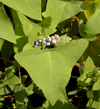
| New CACIWC Publications |
|---|
The Habitat
The Habitat The Habitat The Habitat The Habitat The Habitat
Link to past issues of
|
Welcome

"Dedicated to constant vigilance, judicious management and conservation of our precious natural resources." Mission Statement: "To promote the statutory responsibilities of Connecticut Conservation Commissions and Inland Wetland Commissions and to foster environmental quality through education and through the conservation and protection of wetlands and other natural resources." |
|||
|
Register now to reserve a space at our 2024 Annual Meeting and Environmental Conference on Saturday, November 16, 2024 to celebrate CACIWC's 50th Anniversary at the Bristol Event Center!
CACIWC Conference Registration FormsClick here to download the printable formClick here for our convenient online form Click here for more information
|
 Marshall K. Berger, Jr. |
 Mary M. Mushinsky |

Jason C. White, PhD. |
|
CACIWC members please note:CACIWC has been invited to partner with the Connecticut Department of Energy and Environmental Protection (DEEP) to help develop and implement the next revision (2025) of the Connecticut's State Wildlife Action Plan (SWAP). Would you or your commission would like to be involved with this revision? Please contact us at: board@caciwc.org Information on both the 2025 revision and the existing 2015 plan is located on the DEEP website: Click here
Light Pollution impacts both Wildlife and Climate Change! See information provided by the Coalition to Reduce Light Pollution in Connecticut: Click here Learn how you can help reduce light pollution your town: Click here Watch this site for more information!
|
ALERT
Please report sightings of Spotted Lanternfly Lycorma delictula
 The Connecticut Agricultural Experiment Station (CAES) renewed its Notice of Order of Quarantine on January 1, 2023, to help prevent and slow spread of the Spotted Lanternfly first identified in Fairfield and New Haven Counties. This imported insect pest can feed on more than 70 species of plants and has the potential to threaten half of Connecticut trees. For more information on identifying and reporting sightings of this insect species, please see:
The Connecticut Agricultural Experiment Station (CAES) renewed its Notice of Order of Quarantine on January 1, 2023, to help prevent and slow spread of the Spotted Lanternfly first identified in Fairfield and New Haven Counties. This imported insect pest can feed on more than 70 species of plants and has the potential to threaten half of Connecticut trees. For more information on identifying and reporting sightings of this insect species, please see:
ALERT
Report Sightings of Invasive Mile-A-Minute

 Vine Mile-a-minute vine is a highly invasive annual plant from eastern Asia that can quickly cover, outcompete and replace native vegetation, damaging habitat for native plants and animals. Early detection and rapid response are essential for control. Mile-a-minute was first found in Connecticut in Fairfield County in 1997. Since then, it has spread to 20 Connecticut towns, as far east as Stonington and as far north as Simsbury. Mile-a-minute spreads by seed and quickly grows into dense stands. Seeds are spread by wind and water.
Vine Mile-a-minute vine is a highly invasive annual plant from eastern Asia that can quickly cover, outcompete and replace native vegetation, damaging habitat for native plants and animals. Early detection and rapid response are essential for control. Mile-a-minute was first found in Connecticut in Fairfield County in 1997. Since then, it has spread to 20 Connecticut towns, as far east as Stonington and as far north as Simsbury. Mile-a-minute spreads by seed and quickly grows into dense stands. Seeds are spread by wind and water.
For more information please read: Cheah, Carole and Ellis, Donna 2022. Biological Control of Mile-a-Minute Weed in Connecticut. Connecticut Agricultural Experiment Station Bulletin 1083. June 2022, available at: Click here
For additional information, including questions on reporting, please contact:Carole Cheah, Ph.D.
Research Entomologist Valley Laboratory
The Connecticut Agricultural Experiment Station
153 Cook Hill Road
Windsor, CT 06095
carole.cheah@ct.gov
Search CACIWC.ORG
CC :: IWC :: Tools :: About CACIWC ::Publications :: Support CACIWC ::: Links :: Legislation :: Events
CACIWC, Inc.
deKoven House Community Center
27 Washington Street
Middletown, CT 06457
For questions on our Annual Conference, please email us at AnnualMtg@caciwc.org
For other information on CACIWC, please email us at Board@caciwc.org
© CACIWC, Inc. All rights reserved.
Other Conferences and Workshops
CIPWG Invasive Plant Symposium, October 29, 2024 The Connecticut Invasive Plant Working Group (CIPWG) 2024 symposium Real Talk: Making an Impact in Invasive Plant Management will be in person at UConn Student Union, Storrs, CT on Tuesday, October 29, 2024. Sessions include a variety of techniques for management of terrestrial and aquatic invasives, as well as restoration with native alternatives. CEU's for organizations and Pesticide Recertification Credits are available. For an agenda, early registration link, and other information, see: cipwg.uconn.edu/2024-symposium
Environmental Job PostingsTown of Greenwich, Department of Environmental Affairs seeks part-time Intern through June 2025. Click here for more information.
Town of Ashford is offering a part-time employment opportunity for an agent to provide assistance to the Ashford Inland Wetlands and Watercourses Commission. For additional information contact the Ashford First Selectman's office at 860-487-4400 or cabikoff@ashfordtownhall.org.
The Town of Thompson is hiring an Inland Wetlands Officer & Conservation Agent Please see additional information on this position and the application procedure at: Thompson Inland Wetlands Officer & Conservation Agent position & application info A more detailed job description can be found at: Thompson Inland Wetlands Officer & Conservation Agent detailed description
Conservation Commission Role in Climate Change Resilience: CACIWC encourages all Conservation Commissions to review this Connecticut Institute for Resilience and Climate Adaptation (CIRCA) fact sheet on how to advocate for increasing climate change resiliency within their municipality:
For additional information on Inland Wetlands and Watercourses in Connecticut, including training and regulations, please see this State of Connecticut Department of Energy and Environmental Protection (DEEP) website: Inland Wetlands and Watercourses home page (ct.gov)
Please also see the DEEP Inland Wetlands Agency Directory at: AgentTownStaffDirectorypdf.pdf
For additional information on Connecticut Wildlife including CT species, the National Diversity Data Base, and Reporting a Wildlife Sighting, please see this CT DEEP website: Wildlife in Connecticut
Planning for Agriculture:
|
